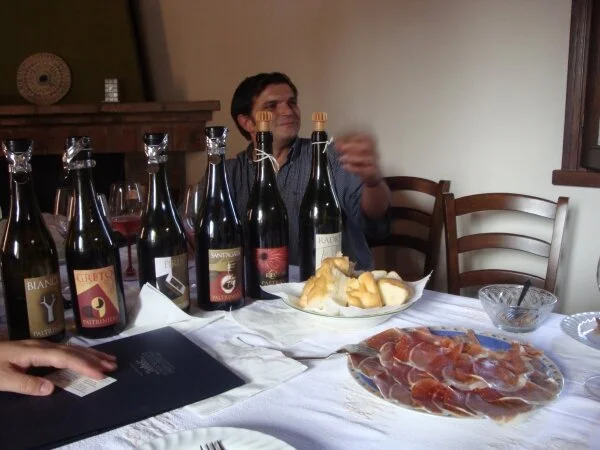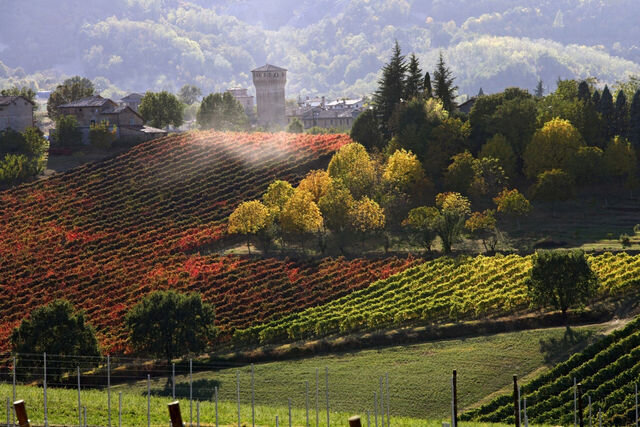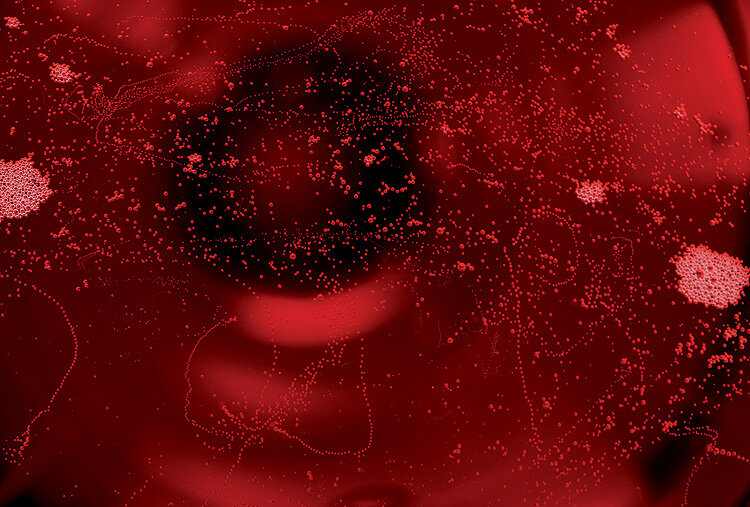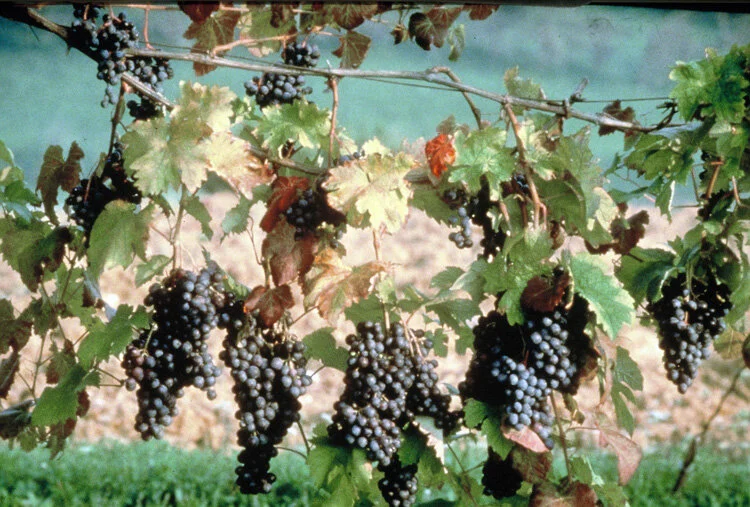Cantina Paltrinieri - Emilia, Italy
LIKE PINOT NOIR FROM BURGUNDY
(WITH BUBBLES)
(Editor’s note. We first visited Alberto and Barbara Paltrinieri on June 16, 2011. We’ve left this article intact as was originally written from 2012. As lovers and believers in Lambrusco wines for a long time, the tone, joy, excitement and essence of the words some time ago speaks to the truth of our own discovery and of the wonder of the best Lambrusco wines. As the first in America to promote the work of Alberto Paltrinieri in partnering with our then Oregon import partner and introducing the wines to customers, we are pleased and proud of the success the winery has gone on to achieve over the last decade. These wines are among the first we knew of to harness the best of the wide swath of Lambrusco wines, which now finally are finding a home in the minds of wine lovers seeking and appreciating individual and artisanal wines — offering the best Italy has to offer. Thus the following article stands as is: a signpost and “historic” marker of a moment - for us - of great and compelling discovery.)
—————————————————
Guess we’re selling stuff... But what we are really doing is spending most of our time and effort to learn more about more wines, to search for those we'll genuinely love, and tell you about them and why we like them. Then, we hope you enjoy them.
It's not that we don't love the great wines we already know, we do.... but we have this wanderlust about wine: what is new? who are the young stars? what about those so called "country wines"? how about those outside the mainstream? did you hear about the guy behind the guy behind the guy outside the far end of the outskirts of the appellation??
This is probably why the 120+ issues of our newsletter are called the E&R Wine Explorer.
REVELATION
Revelations need not be immediate, they can creep in over time.
Take Lambrusco for example.
Allow us tell you what we've learned over the years and why we went to Emilia-Romagna over a decade ago, to the source. And, why there is truth in what must seem our unimaginably unlikely headline at the top regarding LAMBRUSCO:
"LIKE PINOT NOIR FROM BURGUNDY (WITH BUBBLES)"
It really is. Although we have heard or seen no other wine writer say this, there are legitimate and wonderful comparisons to be made between Red Burgundy and these well made Lambrusco wines from Cantina Paltrinieri.
This is a region where place and production levels matter...
you know: do you want fries with that?
And oh yeah, did you want an original, not mass produced jackson pollack... or one of the 2,775,400 copies?
Production levels are important. Here is a true story that just happened at the shop within a few days of this writing. It helps explain two concerns:
1- what does someone know about something (what have they experienced?)
2- size can matter.
We went to the place, the home of the "real" Lambrusco itself to meet, talk, observe, walk the vineyards, learn and taste.
Here is part one of our story of finding two remarkable producers in the Emilia part of Emilia-Romagna (part two in a few months). Come with me and let's begin in Modena's famed Sorbara zone of Lambrusco to the town of Sorbara itself to get to know Cantina Paltrinieri.
ONE MOMENT--FIRST THINGS FIRST! (aka, three things first)
1- The Modena Lambrusco area/region has been making Lambrusco for at least 800 years, some of it must be good! After all, Lambrusco is a dynamic duo: a tasty and low-ish alcohol wine, and it has bubbles - the best of both worlds!
2- Like Champagne, Lambrusco sparkles, and, like Champagne, the Lambrusco region is large and uses different grapes making very different wines.
3- Please... forget everything you know about Lambrusco! Some time ago, Team E&R needed to do just that, and we did. Next, we started all over again and got to know Lambrusco for the first time.
AZIENDA AGRICOLA PALTRINIERI GIANFRANCO: A FAMILY WINERY
It's homespun we know, but what else can you say when the husband and wife team, Alberto and Barbara Paltrinieri (with help from young Cecilia, their daughter and English translator) make the wines themselves from their next door vines at their winery across the yard from their home? Cantina Paltrinieri is located just outside a crossroads of buildings and houses called Sorbara; officially designated as "a peopled place". As does the word and proper name "Barolo", Sorbara shares fame with the Lambrusco di Sorbara grape (see below), as well as the town's name and the region's name. Back in 1926, Alberto's grandfather Achille, built part of the present winery and began making Lambrusco di Sorbara. His son, Gianfranco, whose name is honored in the winery name, took over the farm years later. Today, Gianfranco's nephew, Alberto - who has brought a whole new level of passion and expertise to Lambrusco - runs the winery and makes the wines. Though 1926 is long ago, it's really nothing considering the Romans were making Lambrusco there over 800 years ago.
Cantina Paltrinieri is situated in a magnificent position to those in-the-"Lambrusco-know". The "peopled place", Sorbara, is about eight miles north of the historic, ancient city of Modena, gloriously placed between Bologna to its southeast and Parma to its northwest. This stretch, centered by Modena, is the culinary heart of Europe and contains the finest food in Italy. Within this sector of the Po Valley is Italy's most fertile land, home to the origins of Parmigiano-Reggiano cheese, Balsamic vinegar, Prosciutto, incendiary pastas, Lambrusco wines and many other delights, as well as the home of Ferrari and the birthplace of Luciano Pavarotti and Giuseppe Verdi, whose spirits are entwined with the air, earth and people.
Sorbara is located right smack in the center of a small, special alluvial deposit of profoundly rich soil embedded in the sunny warm climate; easily the finest situation for Lambrusco grapes on earth. Sorbara- sitting between the two rivers; the Secchia and the Panaro- is an exceptionally fertile land which was repeatedly flooded-over ages ago, leaving today's vineyard area submerged in permeable sandy soil that is rich in potassium. This accounts for the intensity of the Sorbara DOC wines, as well as their lighter colors. As Alberto pointed out, there is no need to irrigate. The other Lambrusco zones are based in clay, giving them their characteristic darker color and a more foamy, purply appearance in the glass. This distinction in soil and its impact is crucial in understanding how the Cantina Paltrinieri wines of Sorbara (Sorbara is the town's name and its regional DOC designation, as well as the name of the grape) and its DOC are ultimately not like all the rest. The singular Cantina Paltrinieri style lifts with an airy lightness of weight and aromatic intensity binded to fantastic freshness and purity. These are wines like no others I have tasted to date.
Alberto and Barbara rock. Go see them sometime. Check out their winery and homemade balsamico production. Modena will blow your mind... as well as your food budget. The hills all around, from Parma to Modena to Bologna, are packed with terrific inns to dine and stay at and classy vineyards making super wines. The entire regions oozes relevance in Italian history and culture.
The winery.
LAMBRUSCO AND THE GRAPES
Coincidentally, the New York Times did a feature article on how wonderful Lambrusco can be (7/30/12), but we run no risk of quickly jumping on the bandwagon, as our travel there was well over a year ago. At the same time, to the credit of the Times, it featured articles praising Lambrusco in 2006, 2007, 2008, 2009 and 2010. They get it. (Cantina Paltrinieri is not mentioned in those articles, as they do not export to the NY metro area; fine with us!) Nonetheless, it is easy to understand why consumers could be skeptical about Lambrusco, as it is - perhaps rightfully- not taken seriously. Lambrusco is rife with negative connotation in America. Negativity is not the fault of the grapes or of the five DOC zones of Lambrusco: "Lambrusco Grasparossa di Castelvetro", "Lambrusco di Sorbara", "Lambrusco Salamino di Santa Croce", "Lambrusco Reggiano" and "Lambrusco Mantovano". Similar in misrepresenting the best of a type of grape, like Zinfandel (white) or "Chablis" or "Hearty Red Burgundy" (Gallo), Lambrusco (Riuinte et al.) has suffered a similar fate. All Lambrusco is not bad, some is extraordinary, and, as I suggest above--- forget all you knew about Lambrusco (before today). E&R is proud to have been the first to bring these wines into America.
According to the leading Lambrusco authority of Modena (the "cradle" of Lambrusco!), the "Consorzio Marchio Storico del Lambruschi Modenesi", the Etruscans, and then later, the Romans, grew "Labrusca" vines there from which they made frothy red wines. A whole lotta Lambrusco's been drunk since then (that's according to us). In the forties and fifties, heavily sweetened versions of Lambrusco invaded America which were called the "Coca Cola" of Italy. Even today, Lambrusco is one of the biggest Italian wine exports to America with Riunite, Cella, Bolla and Giacobozzi selling in excess of twenty million bottles a year. (This is a multi-layered mystery to us!) As you will read below, high quality, well-made Lambrusco with complexity and lively, dry fruit is a wholly different wine.
There are some sixty clones of Lambrusco, along with a number of grapes not called Lambrusco, which are in Lambrusco. I will focus on the two farmed by Cantina Paltrinieri for their red wines: Lambrusco di Sorbara and Lambrusco di Salamino.
LAMBRUSCO DI SALAMINO
Lambrusco di Salamino has its own DOC called Lambrusco di Salamino di Santa Croce, in the NW sector of Emilia. While Alberto uses this grape, it is farmed right at Sorbara in a new DOC called Lambrusco di Modena. The Lambrusco di Salamino grape tends to produce a wine of a darker shade with bone-rattling, potent acidity, hence, it is frequently used as a blending grape in the Modena area. Bottles produced from 100% of the grape are rare there, but Alberto felt he could produce an exceptional wine using all Salamino. The Cantina Paltrinieiri "Greto" (see below) is a sensation which will surely be a trendsetter. Alberto, an articulate, knowledgeable and passionate spokesman for his region, graduated from his wine studies in Bologna in 1996 and continues to learn on the job everyday. As he and I walked one of his vineyards, he further explained how the Salamino grape takes it name from its shape. Considering that Emilia is a true haven for meats made of from pork, the silhouette of Salamino is easy to imagine as a broad shouldered salami.
LAMBRUSCO DI SORBARA
Taking its name from its home base of the land in which it has the greatest reputation and fame, "Sorbara" is a town, a grape and the DOC of Lambrusco di Sorbara. The Sorbara grape has been there for a very long time, as proven by mentions in documents remarking on the defeat of Henry IV in 1084. Sorbara grapes are notorious for problems with yields and producing "sterile" grapes, often not pollinated, leaving large portions of the clusters with only tiny, unharvestable grapes. Alberto has lost up to half his Sorbara harvest in certain years. A helpful partial solution for cross pollination is co-planting Salamino alongside Sorbara it the vineyards. At its best, Sorbara creates a magical frizzante wine offering some of the same sophistication and diversity as many village appellation red burgundy. Sorbara, yielding the lightest colored Lambrusco of all, produces fresh, pure wines with scents of violets, and is considered by many as the finest of all Lambrusco grapes. The Sorbara grape is at its best in the sandy, fertile flood plain at the town of Sorbara, which sits between two rivers that both protect and nurture it. More than likely, you have not had wines like Alberto's Cantina Paltrinieri reds; certainly we are aware of no Lambrusco in our market like them. These are vivid, vibrant, stony, dry, fine and super fresh wines with beautiful aromatics and succulent, pure fruit.
Click on each wine for more detail.








